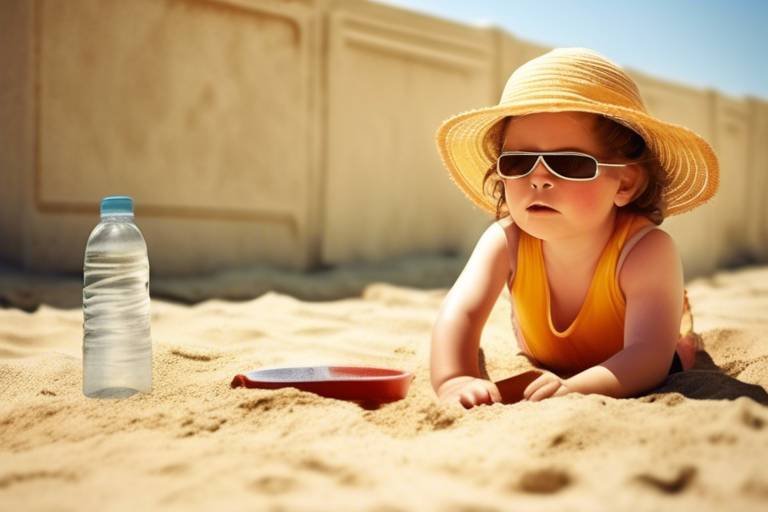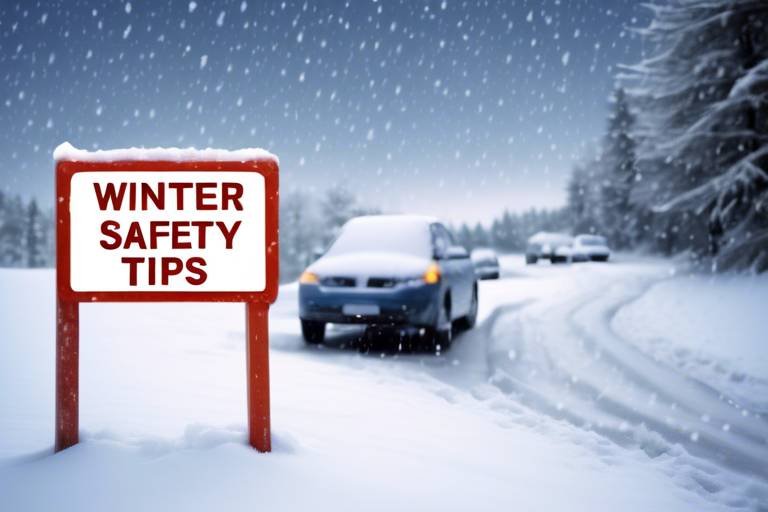Avoiding Heatstroke: Safety in Summer
As the sun blazes overhead and summer fun beckons, it's easy to get swept away in outdoor activities. However, amidst the excitement, we must not forget the potential dangers lurking in the heat, particularly heatstroke. This severe condition can sneak up on even the most vigilant among us, making it essential to arm ourselves with knowledge and strategies to prevent it. After all, who wants to ruin a perfect summer day with a trip to the hospital? By understanding what heatstroke is, recognizing its symptoms, and implementing effective safety measures, we can ensure our summer adventures remain enjoyable and safe.
Heatstroke isn’t just a buzzword; it’s a serious medical emergency that occurs when your body overheats, often due to prolonged exposure to high temperatures. Imagine your body as a finely tuned machine. When it gets too hot, it struggles to function properly, leading to a breakdown that can have dire consequences. The symptoms can escalate quickly, from mild discomfort to life-threatening situations. So, how can we protect ourselves and our loved ones from this summer hazard? Let's dive into the essentials of heatstroke prevention and safety.
Heatstroke is a severe condition caused by prolonged exposure to high temperatures. It can lead to serious health complications, making it crucial to understand its symptoms and prevention methods. When your body temperature rises to 104°F (40°C) or higher, it can begin to damage your brain and other vital organs. This is why it's so important to stay informed and proactive. Think of it as a fire alarm in your home; if you ignore it, the consequences can be catastrophic.
Identifying the symptoms of heatstroke early can save lives. Common signs include confusion, rapid pulse, and high body temperature. Imagine being out on a sunny day, feeling great, and then suddenly, you start to feel dizzy or disoriented. These could be early warning signs of heatstroke. Knowing these indicators is essential for timely intervention. Here are some symptoms to watch out for:
- High body temperature (104°F or higher)
- Altered mental state or confusion
- Rapid heartbeat
- Headache
- Nausea or vomiting
Immediate first aid can be vital for someone experiencing heatstroke. If you or someone you know shows signs of heatstroke, don’t wait. Cooling the person down and seeking medical help can prevent further complications and ensure a better outcome. The quicker you act, the better the chances of recovery. It’s like putting out a small fire before it engulfs your entire home.
Utilizing effective cooling techniques, such as applying ice packs and immersing in cool water, can quickly reduce body temperature and mitigate the effects of heatstroke. Consider these methods:
- Move the person to a cooler place, preferably indoors or in the shade.
- Remove any excess clothing to allow body heat to escape.
- Apply cool, wet cloths or ice packs to areas like the neck, armpits, and groin.
- Immerse the person in cool water if possible.
Understanding the appropriate emergency response steps is critical. Calling for medical assistance and providing basic first aid can significantly impact the person's recovery. Remember, heatstroke is not something to take lightly. Just like you wouldn’t ignore a flat tire on your car, don’t dismiss the signs of heatstroke.
Survivors of heatstroke may face long-term health issues. Awareness of these risks can encourage preventive measures and promote better health practices in the future. Some potential complications include:
- Organ damage
- Neurological issues
- Increased risk of heat-related illnesses in the future
Staying hydrated is key to preventing heatstroke. The hot summer sun can quickly deplete your body's water reserves, so it’s essential to keep sipping throughout the day. This section will discuss effective hydration strategies, including the types of fluids to consume and recommended intake levels. Think of hydration as your body’s fuel; without it, you can’t run smoothly. Aim to drink at least 8-10 glasses of water daily, and consider increasing this amount on particularly hot days or during strenuous activities.
Maintaining electrolyte balance is essential during hot weather. When you sweat, you lose not just water but also vital electrolytes like sodium and potassium. Understanding which electrolytes to replenish can help support overall hydration and prevent heat-related illnesses. Sports drinks or electrolyte tablets can be a good option, but be cautious of excessive sugar content.
Implementing best hydration practices, such as drinking water regularly and avoiding excessive caffeine, can significantly reduce the risk of heatstroke during summer activities. Remember to listen to your body; if you feel thirsty, that’s your cue to hydrate. Additionally, try to consume water-rich foods like fruits and vegetables, which can also contribute to your hydration levels.
Q1: What should I do if I suspect someone has heatstroke?
A1: Call emergency services immediately and begin cooling the person down using the techniques mentioned earlier.
Q2: How can I tell the difference between heat exhaustion and heatstroke?
A2: Heat exhaustion may involve heavy sweating, weakness, and dizziness, while heatstroke is characterized by a high body temperature and altered mental state.
Q3: Are certain people more at risk for heatstroke?
A3: Yes, individuals such as the elderly, young children, and those with certain medical conditions are at a higher risk.
Q4: Can I prevent heatstroke?
A4: Absolutely! Staying hydrated, taking breaks in the shade, and wearing light clothing can help prevent heatstroke.

Understanding Heatstroke
Heatstroke is not just a buzzword thrown around during the sweltering summer months; it's a serious medical condition that can arise when the body overheats, often due to prolonged exposure to high temperatures. When your body temperature rises above 104°F (40°C), it can lead to significant health risks, including organ failure and even death. Think of your body as a finely tuned machine; when it overheats, it starts to malfunction. The body's natural cooling mechanisms, like sweating, may become overwhelmed, leaving you vulnerable to this dangerous condition.
What happens during heatstroke? Well, the body’s temperature regulation system goes haywire. It can no longer cool itself effectively, and the core temperature begins to rise. This is particularly concerning for vulnerable populations such as the elderly, young children, and those with pre-existing health conditions. The risk of heatstroke escalates during outdoor activities, especially if you're not taking the necessary precautions. Imagine being out in the sun, feeling that warm embrace, but then suddenly realizing that it’s turning into a scorching grip that could endanger your health.
There are several factors that contribute to the risk of heatstroke, including:
- High Humidity: When humidity is high, sweat doesn't evaporate as efficiently, making it harder for the body to cool down.
- Intense Physical Activity: Engaging in strenuous activities, especially during peak heat hours, can quickly raise your body temperature.
- Dehydration: Not drinking enough fluids can hinder your body's ability to sweat and cool down.
- Age and Health Conditions: Older adults and those with certain health conditions are at a higher risk.
Understanding the intricacies of heatstroke is essential for prevention. By recognizing the environmental and personal factors that contribute to this condition, you can take proactive steps to protect yourself and those around you. Whether it's planning outdoor activities for cooler parts of the day or ensuring you have plenty of fluids on hand, being informed is your best defense. Remember, heatstroke is not just about feeling hot; it's about recognizing that your body needs help before it reaches a critical state.
In summary, heatstroke is a dire situation that can escalate quickly if not addressed. By understanding what it is and the factors that contribute to it, you can arm yourself with the knowledge necessary to stay safe in the sun. So, the next time you're planning a summer outing, think about the heat and how your body responds to it. Your health is worth the extra effort!

Recognizing Symptoms
When the summer sun is blazing, it's essential to be vigilant about the signs of heatstroke. This condition can sneak up on anyone, especially during outdoor activities like hiking, sports, or even just lounging in the backyard. The symptoms of heatstroke can be subtle at first, but they escalate quickly, making it crucial to recognize them early on. So, what should you be looking for? Here are some common indicators:
- High Body Temperature: A body temperature of 104°F (40°C) or higher is a red flag. This is your body screaming for help!
- Confusion or Altered Mental State: If someone seems disoriented, confused, or is behaving unusually, it could be a sign that heatstroke is setting in.
- Rapid Pulse: An unusually fast heartbeat can indicate that the body is under severe stress.
- Hot, Dry Skin: Unlike heat exhaustion, where sweating is common, heatstroke often results in dry skin due to the body’s inability to cool down.
- Nausea or Vomiting: Feeling sick to your stomach can be another symptom that shouldn't be ignored.
Recognizing these symptoms can mean the difference between a quick recovery and a medical emergency. If you or someone around you begins to show these signs, it’s vital to act fast. Remember, heatstroke doesn’t just affect the elderly or those with pre-existing conditions; it can strike anyone, regardless of age or fitness level. So, stay alert!
Moreover, if you notice someone displaying these symptoms, don’t hesitate to take action. Cooling the person down as quickly as possible is crucial. You can do this by moving them to a shaded area, removing excess clothing, and applying cool compresses to their skin. The sooner you intervene, the better the chances of avoiding serious complications.
Immediate first aid can be vital for someone experiencing heatstroke. Cooling the person down and seeking medical help can prevent further complications and ensure a better outcome.
Utilizing effective cooling techniques, such as applying ice packs and immersing in cool water, can quickly reduce body temperature and mitigate the effects of heatstroke.
Understanding the appropriate emergency response steps is critical. Calling for medical assistance and providing basic first aid can significantly impact the person's recovery.

First Aid for Heatstroke
When someone is experiencing heatstroke, acting quickly can be the difference between life and death. The first thing to remember is that heatstroke is a medical emergency, and prompt action is essential. If you suspect someone has heatstroke, immediate cooling measures should be taken while waiting for professional medical help to arrive. Start by moving the person to a cooler environment, preferably indoors or into the shade, to prevent further heat exposure.
Next, you’ll want to cool the person down as quickly as possible. This can be achieved through several methods:
- Remove any excess clothing to allow heat to escape.
- Apply cool, wet cloths or ice packs to areas where blood vessels are close to the skin, such as the neck, armpits, and groin.
- If available, immerse the person in a cool bath or shower. This is one of the most effective ways to lower the body temperature rapidly.
During this process, keep a close eye on the individual's condition. If they are conscious and able to swallow, offer them cool water or an electrolyte drink to help rehydrate. However, avoid giving them anything if they are disoriented or unconscious, as this could lead to choking.
While performing these first aid measures, it’s crucial to call for emergency medical assistance as soon as possible. Explain the situation clearly to the dispatcher, and follow any instructions they provide. Remember, even if the person seems to improve, they still need to be evaluated by a healthcare professional to rule out any potential complications.
In summary, the first aid steps for heatstroke include:
- Move the person to a cooler area.
- Remove excess clothing.
- Apply cool cloths or ice packs.
- Immerse them in cool water if possible.
- Provide fluids if they are conscious.
- Call for emergency medical help.
By being prepared and knowing these first aid steps, you can play a vital role in saving a life during those sweltering summer months. Remember, heatstroke can happen to anyone—so stay alert, stay informed, and keep cool!
Here are some common questions regarding heatstroke and its prevention:
- What are the main causes of heatstroke? Heatstroke is primarily caused by prolonged exposure to high temperatures, often exacerbated by physical exertion and dehydration.
- Who is at risk for heatstroke? Anyone can suffer from heatstroke, but those most at risk include the elderly, young children, athletes, and individuals with certain medical conditions.
- How can I prevent heatstroke during outdoor activities? Staying hydrated, wearing light clothing, taking breaks in the shade, and avoiding strenuous activity during peak heat hours can help prevent heatstroke.
- What should I do if I suspect someone has heatstroke? Follow the first aid steps outlined above and seek emergency medical assistance immediately.

Cooling Techniques
When it comes to for heatstroke, every second counts. The primary goal is to lower the body temperature as quickly as possible to prevent serious health complications. One of the most effective methods is immersing the person in cool water. This could be a bathtub, pool, or even a large bucket if no other options are available. The cool water envelops the body, allowing for rapid heat dissipation. But what if you don’t have access to water? No worries! There are several other techniques you can employ.
Applying ice packs to key areas of the body can also help. Focus on the neck, armpits, and groin—these areas have major blood vessels close to the skin, making them prime spots for cooling down the body. Wrap ice packs in a cloth to prevent frostbite and place them on these areas for maximum effect. If ice packs are not available, even a bag of frozen vegetables can do the trick!
Another effective technique is to use a fan or air conditioning. If you can get the person into a cool room, that's ideal. If not, create a makeshift cooling system by placing a fan in front of a bowl of ice. As the fan blows air over the ice, it creates a refreshing breeze that can help lower the body temperature. Additionally, removing excess clothing can facilitate heat loss. The less material there is, the easier it is for the body to cool down.
It’s also important to monitor the person's condition closely. If they are conscious, encourage them to drink cool fluids—preferably water or an electrolyte-replenishing drink. This will not only help in cooling their body but also rehydrate them, which is crucial in heatstroke situations. Remember, while these techniques can be lifesaving, they are not substitutes for professional medical help. If you suspect someone is experiencing heatstroke, call for emergency assistance immediately.
- What is the first sign of heatstroke? The first signs may include confusion, dizziness, and a high body temperature.
- How quickly should I cool someone down? You should start cooling them down immediately, as every second counts in preventing serious complications.
- Can heatstroke be fatal? Yes, heatstroke can be fatal if not treated promptly. It can lead to organ failure and other severe health issues.
- What fluids should I give someone suffering from heatstroke? Water is best, but electrolyte drinks can also be beneficial for rehydration.

Emergency Response
When it comes to heatstroke, every second counts. Understanding the appropriate steps can make a world of difference in saving someone's life. First and foremost, if you suspect someone is experiencing heatstroke, do not hesitate to call for medical assistance. This is crucial because professional help is necessary to address the severe complications that can arise from this condition.
While waiting for medical personnel to arrive, there are immediate actions you can take to help the affected person. Start by moving them to a cooler environment, preferably indoors or into the shade. This simple action can significantly lower their body temperature. If possible, remove any excess clothing to allow their skin to cool down more effectively. Remember, the goal is to cool the body as quickly as possible.
Next, you can use various cooling techniques to aid in their recovery. For instance, applying ice packs or cold, wet cloths to areas where blood vessels are close to the surface, such as the neck, armpits, and groin, can help lower their temperature. Alternatively, immersing the person in cool water can be one of the most effective methods to rapidly decrease body heat. If immersion isn’t feasible, using a fan to circulate air around them can provide relief as well.
It’s also important to monitor their condition closely while waiting for help. Keep an eye on their consciousness level and vital signs. If they become unresponsive or their breathing becomes irregular, be prepared to perform CPR if you are trained to do so. This is where knowing the basics of first aid can truly be lifesaving.
In summary, the emergency response to heatstroke involves:
- Calling for medical help immediately
- Moving the person to a cooler environment
- Removing excess clothing
- Applying ice packs or immersing in cool water
- Monitoring their condition closely
By taking these steps, you can help stabilize someone experiencing heatstroke until professional medical assistance arrives, ultimately improving their chances of a full recovery.
Q1: What are the first signs of heatstroke?
A1: The first signs can include confusion, a rapid pulse, and a high body temperature. Look for any sudden behavioral changes.
Q2: How can I prevent heatstroke during outdoor activities?
A2: Stay hydrated, take regular breaks in the shade, and wear light-colored, loose-fitting clothing to help regulate your body temperature.
Q3: What should I do if I suspect someone has heatstroke?
A3: Call for medical help immediately, move them to a cooler place, and begin cooling techniques while waiting for assistance.
Q4: Can heatstroke have long-term effects?
A4: Yes, survivors can experience long-term health issues, including heat intolerance and damage to internal organs.

Long-term Health Risks
Experiencing heatstroke is not just a momentary scare; it can have lasting effects on your health. While many people may recover fully after a heatstroke incident, others might face a range of long-term health complications that can impact their quality of life. One of the most concerning outcomes is the potential for damage to the brain and other vital organs. When the body overheats, it can lead to cellular damage, which might not be immediately apparent but can manifest over time.
Research indicates that individuals who have suffered from heatstroke are at a higher risk for developing neurological issues, including memory problems, concentration difficulties, and even mood disorders. This is because the brain, being highly sensitive to temperature changes, can suffer from inflammation and other forms of injury during extreme heat exposure. Furthermore, heatstroke can disrupt the body's ability to regulate temperature in the future, leaving survivors more vulnerable to heat-related illnesses.
In addition to neurological risks, heatstroke can also affect cardiovascular health. The stress of overheating can put a strain on the heart, potentially leading to long-term heart complications. Individuals may experience increased heart rates or blood pressure issues, which can escalate into more severe conditions if not monitored. Moreover, those with pre-existing health conditions such as asthma or diabetes may find their symptoms exacerbated after a heatstroke incident.
To better understand the potential long-term health risks associated with heatstroke, consider the following key points:
- Neurological Issues: Memory loss, mood swings, and cognitive difficulties.
- Cardiovascular Problems: Increased heart rate, blood pressure issues, and potential heart disease.
- Thermoregulation Issues: Difficulty in regulating body temperature in future heat exposure.
Given these risks, it becomes increasingly important for individuals to take preventive measures seriously. By understanding the potential long-term effects of heatstroke, we can encourage ourselves and those around us to adopt safer practices during the hot summer months. Awareness and action can significantly reduce the likelihood of experiencing heatstroke and its associated health complications.
Q: What are the immediate symptoms of heatstroke?
A: Common symptoms include confusion, rapid pulse, high body temperature, and hot, dry skin. If you notice these signs, it's crucial to seek help immediately.
Q: How can I stay hydrated during extreme heat?
A: Drink plenty of water throughout the day, and consider beverages that replenish electrolytes. Avoid excessive caffeine and alcohol, as they can dehydrate you.
Q: Are there specific groups at higher risk for heatstroke?
A: Yes, children, the elderly, and individuals with pre-existing health conditions are at a higher risk. It's essential for caregivers and family members to be vigilant during hot weather.

Hydration Strategies
When it comes to preventing heatstroke, hydration is your best friend during the scorching summer months. Imagine your body as a well-tuned engine; without enough fuel, it simply won't run efficiently. Water is that fuel, and staying hydrated means you can keep your engine running smoothly, even in the heat. So, how do you ensure you're drinking enough? It's not just about chugging water when you're thirsty; it's about making hydration a part of your daily routine.
One effective strategy is to establish a hydration schedule. For instance, aim to drink a glass of water every hour, especially when you're outside in the sun. You might also consider setting reminders on your phone or using a water tracking app. This way, you won't forget to hydrate, even when you're caught up in summer activities. Additionally, keep a reusable water bottle with you at all times. Not only is it environmentally friendly, but it also serves as a visual reminder to sip throughout the day.
But hydration isn't just about plain water. In fact, consuming a variety of fluids can help maintain your hydration levels. Here are some excellent options:
- Electrolyte Drinks: These are especially useful during intense physical activities, as they help replace lost minerals.
- Fruits and Vegetables: Foods like watermelon, cucumbers, and oranges have high water content and can contribute to your daily hydration.
- Herbal Teas: These can be refreshing and hydrating without the caffeine kick that can sometimes lead to dehydration.
It's important to note that during hot weather, your body loses more fluids through sweat. Therefore, you should increase your fluid intake, especially if you're engaging in outdoor activities. A good rule of thumb is to drink at least 8-10 cups of water daily, but this may vary depending on your activity level and the heat. Always listen to your body; if you're feeling thirsty, it's a sign you need to hydrate!
Additionally, be mindful of your electrolyte balance. Electrolytes are minerals that help regulate various bodily functions, including hydration. Key electrolytes include sodium, potassium, and magnesium. When you sweat, you lose these essential minerals, which can lead to dehydration and heat-related illnesses. To replenish your electrolytes, consider consuming sports drinks or snacks rich in these minerals, such as bananas (for potassium) or pretzels (for sodium).
Lastly, let's not forget about the importance of avoiding excessive caffeine and alcohol during the summer. While that iced coffee or cocktail might seem refreshing, both can lead to increased dehydration. Instead, opt for hydrating beverages that will keep you cool and refreshed without the diuretic effects of caffeine and alcohol.
Q: How much water should I drink on hot days?
A: Aim for at least 8-10 cups of water daily, but increase this amount if you're active outdoors or sweating heavily.
Q: Can I rely on thirst alone to gauge my hydration?
A: While thirst is a good indicator, it's best to drink regularly throughout the day, especially in hot weather.
Q: Are there any signs that I might be dehydrated?
A: Yes! Common signs of dehydration include dry mouth, fatigue, dizziness, and dark yellow urine.

Electrolyte Balance
When the sun blazes down during those hot summer days, our bodies sweat to cool off. But did you know that sweating isn't just about losing water? It’s also about losing electrolytes—those tiny minerals that play a huge role in keeping our bodies functioning properly. Electrolytes, such as sodium, potassium, calcium, and magnesium, help regulate nerve function, muscle contractions, and hydration levels. So, when you're out enjoying the sunshine, it's essential to keep your electrolyte balance in check to prevent heat-related illnesses like heatstroke.
Imagine your body as a high-performance vehicle. Just like a car needs the right fuel and oil to run smoothly, your body requires the right balance of electrolytes to function optimally. When you sweat, you lose not only water but also these vital minerals. If you don't replenish them, your body can become like a car running on empty—overheating and breaking down. This is especially critical for athletes or anyone engaging in outdoor activities during the peak heat of summer.
So, how do you maintain that all-important electrolyte balance? First, it's crucial to understand which electrolytes are most affected by heat and sweating:
- Sodium: Helps regulate water balance and blood pressure.
- Potassium: Essential for muscle function and heart health.
- Calcium: Important for bone health and muscle contractions.
- Magnesium: Aids in muscle and nerve function, as well as energy production.
To keep your electrolytes balanced, consider incorporating foods and drinks that are rich in these minerals into your diet. For instance, fruits like bananas and oranges are excellent sources of potassium, while dairy products provide calcium. Additionally, sports drinks can be beneficial, especially during prolonged activities, as they are specifically formulated to replenish both fluids and electrolytes.
| Electrolyte | Sources | Benefits |
|---|---|---|
| Sodium | Salt, pickles, olives | Regulates fluid balance |
| Potassium | Bananas, spinach, sweet potatoes | Supports muscle function |
| Calcium | Dairy, leafy greens, almonds | Essential for bone and teeth health |
| Magnesium | Nuts, seeds, whole grains | Aids in energy production |
In conclusion, keeping your electrolyte levels balanced is a simple yet effective way to stay safe and healthy during the hot summer months. Remember, it's not just about drinking water; it's about replenishing those vital minerals that keep your body running smoothly. So next time you’re out in the sun, think of your electrolytes as your body’s unsung heroes—essential for your summer adventures!
Q: How can I tell if I’m dehydrated?
A: Look for signs like dry mouth, fatigue, dizziness, or dark yellow urine. If you notice these symptoms, it’s time to hydrate!
Q: Can I rely solely on sports drinks for hydration?
A: While sports drinks can help replenish electrolytes, it’s best to consume a variety of fluids and foods for optimal hydration.
Q: How much water should I drink on hot days?
A: Aim for at least 8-10 cups of water daily, but increase this amount if you are active or sweating heavily.

Best Hydration Practices
This article discusses essential strategies to prevent heatstroke during the summer months, highlighting the importance of hydration, recognizing symptoms, and implementing safety measures for outdoor activities.
Heatstroke is a severe condition caused by prolonged exposure to high temperatures. It can lead to serious health complications, making it crucial to understand its symptoms and prevention methods.
Identifying the symptoms of heatstroke early can save lives. Common signs include confusion, rapid pulse, and high body temperature. Knowing these indicators is essential for timely intervention.
Immediate first aid can be vital for someone experiencing heatstroke. Cooling the person down and seeking medical help can prevent further complications and ensure a better outcome.
Utilizing effective cooling techniques, such as applying ice packs and immersing in cool water, can quickly reduce body temperature and mitigate the effects of heatstroke.
Understanding the appropriate emergency response steps is critical. Calling for medical assistance and providing basic first aid can significantly impact the person's recovery.
Survivors of heatstroke may face long-term health issues. Awareness of these risks can encourage preventive measures and promote better health practices in the future.
Staying hydrated is key to preventing heatstroke. This section will discuss effective hydration strategies, including the types of fluids to consume and recommended intake levels.
When it comes to hydration, especially during the sweltering summer months, there are a few best practices that can make all the difference. First and foremost, it’s essential to drink water regularly, even if you don’t feel thirsty. Think of your body as a plant; if you wait too long to water it, it might wilt. Aim to consume at least 8-10 glasses of water a day, and increase this amount if you’re engaging in outdoor activities or exercising.
In addition to water, incorporating electrolyte-rich drinks can be beneficial, especially after intense physical activity. Sports drinks, coconut water, or even homemade electrolyte solutions can help replenish lost minerals. It’s important to strike a balance; while hydration is crucial, too much caffeine or alcohol can lead to dehydration, so it’s best to limit those beverages during the heat.
Furthermore, pay attention to the color of your urine. Light yellow is a good sign of proper hydration, while dark yellow or amber indicates you need to drink more fluids. If you’re planning on spending a lot of time outdoors, consider carrying a refillable water bottle with you. This not only helps you keep track of your intake but also encourages you to sip water throughout the day.
Finally, remember that hydration isn’t just about drinking fluids; it also includes consuming foods with high water content. Fruits and vegetables like watermelon, cucumbers, and oranges can contribute significantly to your hydration levels while providing essential nutrients.
- How can I tell if I'm dehydrated? Look for signs such as dry mouth, fatigue, dizziness, and dark yellow urine.
- What are the best drinks for hydration? Water is best, but electrolyte drinks can be beneficial after exercise.
- How much water should I drink daily? Aim for at least 8-10 glasses, adjusting based on activity level and heat exposure.
- Can I hydrate through food? Yes, many fruits and vegetables have high water content and can aid in hydration.
Frequently Asked Questions
- What is heatstroke and how does it occur?
Heatstroke is a serious condition that occurs when the body overheats, typically due to prolonged exposure to high temperatures. It can happen during intense exercise or even just by being outside in the sun for too long. When the body temperature rises above 104°F (40°C), it can lead to organ damage and other severe health issues.
- What are the common symptoms of heatstroke?
Recognizing the symptoms of heatstroke is crucial for timely intervention. Common signs include confusion, rapid heartbeat, headache, dizziness, and high body temperature. If you notice someone exhibiting these symptoms, it’s essential to act quickly to cool them down and seek medical assistance.
- How can I prevent heatstroke during summer activities?
Preventing heatstroke is all about staying hydrated and being mindful of your surroundings. Make sure to drink plenty of water, wear lightweight and light-colored clothing, and take regular breaks in the shade. Avoid strenuous activities during the hottest parts of the day, and listen to your body—if you start feeling dizzy or unwell, it’s time to cool off!
- What should I do if someone is experiencing heatstroke?
If you suspect someone has heatstroke, immediately move them to a cooler place, preferably indoors or in the shade. Remove any excess clothing and apply cool water to their skin or use ice packs on their neck, armpits, and groin. Call emergency services right away, as professional medical help is crucial in these situations.
- How important is hydration in preventing heat-related illnesses?
Hydration is key! Drinking enough fluids, especially water and electrolyte-rich drinks, helps regulate your body temperature and keeps you energized. It’s important to start hydrating before you feel thirsty, as thirst is often a sign that your body is already becoming dehydrated.
- What are the best hydration practices for hot weather?
During hot weather, aim to drink water regularly throughout the day. Avoid excessive caffeine and alcohol, as these can lead to dehydration. Consider consuming drinks that contain electrolytes, especially if you’re sweating a lot. Remember, staying hydrated is a continuous process, not just something to think about when you’re outdoors!
- Can heatstroke have long-term health effects?
Yes, survivors of heatstroke can face long-term health complications, including issues with their kidneys, liver, and even neurological problems. This is why it’s so important to recognize the signs early and take preventive measures seriously to avoid the risks associated with this dangerous condition.



















